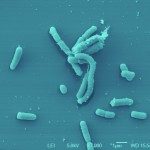Link to Pubmed [PMID] – 34133202
Link to DOI – e00217-2110.1128/mSphere.00217-21
mSphere 2021 Jun; 6(3): e0021721
Macrophages are important immune cells that are involved in the elimination of microbial pathogens. Following host invasion, macrophages are recruited to the site of infection, where they launch antimicrobial defense mechanisms. Effective microbial clearance by macrophages depends on phagocytosis and phagolysosomal killing mediated by oxidative burst, acidification, and degradative enzymes. However, some pathogenic microorganisms, including some drug-resistant bacteria, have evolved sophisticated mechanisms to prevent phagocytosis or escape intracellular degradation. Cold atmospheric plasma (CAP) is an emerging technology with promising bactericidal effects. Here, we investigated the effect of CAP on Staphylococcus aureus phagocytosis by RAW 264.7 macrophage-like cells. We demonstrate that CAP treatment increases intracellular concentrations of reactive oxygen species (ROS) and nitric oxide and promotes the elimination of both antibiotic-sensitive and antibiotic-resistant S. aureus by RAW 264.7 cells. This effect was inhibited by antioxidants indicating that the bactericidal effect of CAP was mediated by oxidative killing of intracellular bacteria. Furthermore, we show that CAP promotes the association of S. aureus to lysosomal-associated membrane protein 1 (LAMP-1)-positive phagosomes, in which bacteria are exposed to low pH and cathepsin D hydrolase. Taken together, our results provide the first evidence that CAP activates defense mechanisms of macrophages, ultimately leading to bacterial elimination. IMPORTANCE Staphylococcus aureus is the most frequent cause of skin and soft tissue infections. Treatment failures are increasingly common due to antibiotic resistance and the emergence of resistant strains. Macrophages participate in the first line of immune defense and are critical for coordinated defense against pathogenic bacteria. However, S. aureus has evolved sophisticated mechanisms to escape macrophage killing. In the quest to identify novel antimicrobial therapeutic approaches, we investigated the activity of cold atmospheric plasma (CAP) on macrophages infected with S. aureus. Here, we show that CAP treatment promotes macrophage ability to eliminate internalized bacteria. Importantly, CAP could trigger killing of both antibiotic-sensitive and antibiotic-resistant strains of S. aureus. While CAP did not affect the internalization capacity of macrophages, it increased oxidative-dependent bactericidal activity and promoted the formation of degradative phagosomes. Our study shows that CAP has beneficial effects on macrophage defense mechanisms and may potentially be useful in adjuvant antimicrobial therapies.




